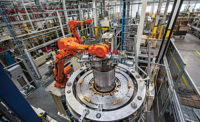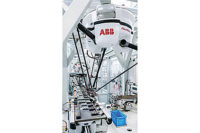Every year, millions of people worldwide buy and use household appliances made by AB Electrolux. These products include microwave ovens, dishwashers, washing machines, dryers, stoves, vacuum cleaners and water heaters sold under brand names like Westinghouse, Chef and Electrolux.
The products are made at more than 20 Electrolux plants in North America, Europe, China, India and Australia. One plant in Adelaide, South Australia, employees nearly 450 people and makes nearly 1,300 stoves daily.
The stoves’ outer doors are assembled in a compact, automated production cell equipped with seven robots supplied by ABB Australia. Six IRB2600 robots are used, along with a model IRB4600. Leviathan Design, based in Rowville, Melbourne, designed, built and installed all cell components: conveyors, robot grippers, curing oven, regrip tables and assembly table.
“A critical requirement of the project was to achieve a cycle time of 14 seconds,” says Glenn Westonsmith, sales engineer at Leviathan Design. “We used ABB’s Robot Studio software to simulate system capability. This simulation was continually updated and tested throughout the project to check the cycle time.”
Within the cell, powder-coated or stainless steel trim and plastic injection-molded columns are bonded to a painted glass panel to form the outer door. Robot one retrieves trim from a conveyor and places it on a regrip table, where robot two treats the trim with plasma for better silicon adhesion. Robot one then retrieves the trim and places it on the assembly table.
Simultaneously, robot three picks up a glass panel from a stack and confirms its proper orientation using a vision system featuring Cognex ISM 1050 cameras. The robot applies a label, checks the label’s bar code with the vision system, and places the panel on a regrip table. Robot four then picks up the glass, applies a silicon bead and joins it to the metal trim on the assembly table.
Nearby, robot five picks up plastic columns from trays, treats them with plasma, and places them on a regrip table. The columns are retrieved by robot six, which applies silicon beads to them and joins them to the glass on the assembly table.
Finally, robot seven (IRB4600) lifts the assembled door and places it into a curing oven for 20 minutes. The cured door is retrieved by the robot and placed on a tab on an overhead conveyor. The tabs keep the doors aligned.
“With its longer reach, the IRB4600 can pick the doors at 900 millimeters high and place them onto the conveyor at 4.5 meters high,” explains Westonsmith. “The robot sits on a 2-meter-high stand to enable this reach.”
Westonsmith says the conveyor is high enough off the ground to provide access underneath for forklifts and cranes, as well as pedestrians. The conveyor moves the doors 45 meters to a transfer unit, which lifts, rotates 90 degrees and places the doors into a buffer cell.
“From there another IRB4600 moves the doors into a storage cell,” continues Westonsmith. “As doors are required for production, the robot loads them onto out-feed conveyors. Doors are picked on a first-in, first-out basis.”
Electrolux likes that the cell optimizes limited floor space. The manufacturer also likes that the cell enables the company to control up to four IRB2600 robots with just one controller. This setup simplifies wiring and reduces wiring cost.
For more information on assembly robots, call 248-391-9000 or visit www.abb.com/robotics.



